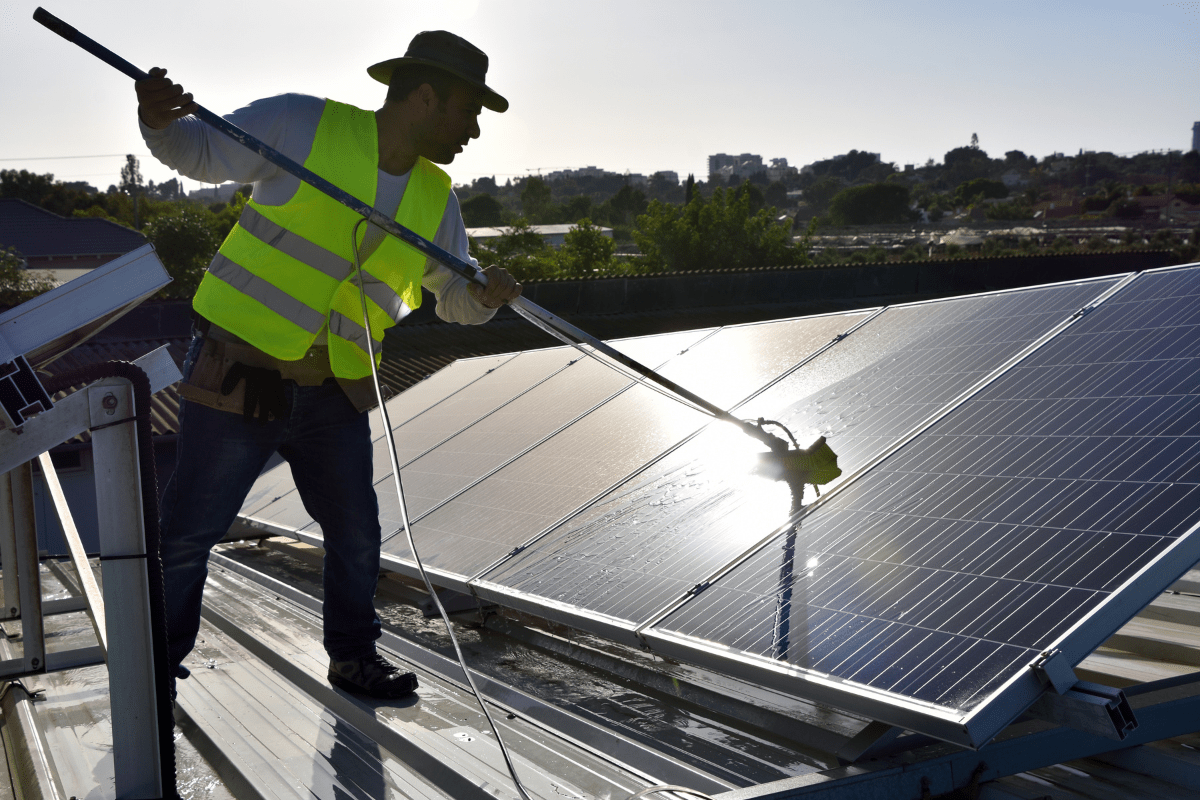
Story by Sara Carbone, CollectiveSun Content Marketing Manager
“Being able to be a leader in renewable energy is an exciting development for us. We serve as an example to others, our students and staff and visitors, of an organization that is able to operate sustainably for future generations.” This observation is from Superintendent of Schools, Craig Fieleg, at Mascoutah School District in Illinois. Mascoutah recently partnered with CollectiveSun to install their 1,326 kW solar system on two of their schools.
Across the United States there are many educational organizations like Mascoutah that have chosen to embrace renewable energy. It’s a movement driven by community leaders like Craig who understand the profound difference solar makes for current and future generations. Gabrielle Wong-Parodi, co-author of a recent study on solar in school, stated, “This is an action we can take that benefits the environment and human health in a real, meaningful way.”
As part of our mission to impact as many nonprofits as possible, CollectiveSun has been able to work with organizations across a host of industries as they go solar. The Solar Inspiration series highlights industries we’ve participated in, with an emphasis on our work with organizations in those industries. Our first four articles have highlighted museums and other art and cultural institutions, houses of worship, the powerful impact of solar on congregations, and healthcare institutions. In this fifth article we look at how educational institutions in America are embracing renewable energy.
“ Solar allows schools to run on clean energy and reduce their greenhouse gas emissions and dependence on outsourced fossil fuels, actions that tend to be supported by students concerned about the future. ”
Educational Institutions and Solar
7,332 K-12 public and private schools or 16% of all districts currently use solar power in America, representing a 139% increase in the amount of solar installed in schools since 2014. This means that 5.3 million students are currently attending a school using solar. States with the highest number of schools with solar are California, New Jersey, Arizona, Massachusetts, and Indiana. Clearly, solar is on the rise in America’s schools.
While some may perceive school solar installations as difficult given the agreement among schools and their teachers for increased school funding, smaller class sizes and higher wages, in reality 60% of our nation’s schools can cost-effectively go solar. In many states there are incentives for them to do so, such as in New York and California where there are strong programs incentivizing solar. Laura Capps, president of Santa Barbara Unified School District’s Board, a district that has gone solar, said, “You don’t get to do this only in high-income areas. It’s a stereotype that this is a luxury. This isn’t just for fancy schools, this is for every school.”
There are financing options for educational institutions that help make solar a reality. Some schools without the ability to pay cash upfront contract a company to install, own and operate the system and sell electricity to the school at a set rate. CollectiveSun offers a financing option uniquely designed to help schools and universities go solar at a lower cost. Our Solar Power Agreement (SPA) is a prepaid service contract that monetizes tax credits normally unavailable to nonprofits and tax-exempt organizations. When the Mascoutah School District went solar they chose a partnership with CollectiveSun because, as Craig Fiegel explained, “it gave us the opportunity to get a discount on the installation price. We ended up saving 12% on the contractor’s bid, something we wouldn’t have been able to do otherwise.”
Why Schools Go Solar
Solar provides significant environmental benefits for schools. In the US, educational institutions are responsible for about 11% of energy consumption by buildings and 4% of carbon emissions. Solar allows schools to run on clean energy and reduce their greenhouse gas emissions and dependence on outsourced fossil fuels, actions that tend to be supported by students concerned about the future. A 2019 study found that solar can meet up to 75% of a school’s electricity needs and reduce the overall education sector’s carbon footprint by 28%. Additionally, a solar installation promotes renewables in schools and their communities, often motivating others to make the shift.
Solar also offers a level of autonomy in the event of a power outage. In an effort to provide preparedness for the city, Santa Barbara Unified School District began the process of going solar in 2018. District leaders looked at solar after a destructive mudslide and wildfire hit California the year before, something that had them recognize the need for disaster readiness and energy independence for both the schools and the community. They created a microgrid solar system that provides and stores energy at six sites and provides power at eight more sites in their schools, district office, and a warehouse. The systems supply 94% of the district’s energy needs and provide power in case of emergencies. “Our schools really should be a safe haven during times of disaster, they’re our neighborhood cornerstones,” said Laura Capps, who spearheaded the project. “If we can keep the lights on when there are power outages or climate-related extreme weather events, which we know are exponentially on the rise, it will be better for the entire community.”
Additionally, schools with solar are likely to teach students about renewables and environmentalism, paving the way for a clean energy future. Often, schools integrate solar energy into their math and science curriculums. Some schools use data from their on-site solar energy systems to help students handle math or understand how the shifting panel angles impact power production. Roxbury Latin School in Boston made their solar system part of the school’s science curriculum and has an interactive kiosk allowing students access to system data where they measure the panel output. The Chisago Lakes School District in Minnesota is 100% solar in a county that has branded itself the Solar Capital of Minnesota with 20,000+ homes solar-powered. All five of the district’s buildings have a 40 kWh solar display on their roofs consisting of 15,000 panels with savings estimated to be between $3 and $6 million over 30 years. “Our students don’t see solar energy as an alternative energy source. It is the energy source that has powered every building that they have ever learned in,” one teacher said. Laura Capps at Santa Barbara USD shared a similar sentiment: “A preschool was our first building…I like the symbolism of a preschool, that for these 4-and 5-year-old children, solar is what they’re going to know in their lifetime.”
Savings from lower operating expenses is another reason schools go solar. Schools often have significant electric bills. The U.S. Department of Energy estimates K-12 schools spend more than $6 billion per year on energy, a cost only second to salaries in most districts. At universities, it comes to more than $14 billion. Solar helps offset these utility costs, safeguard against volatile utility rates, and generate savings that can go directly back to classrooms. Educational institutions often have an abundance of flat, unshaded roof space and large parking lots free of shade that offer great potential for solar energy generation and, thus, great potential for savings. Generally speaking, the larger the solar system, the lower the cost per watt, so schools and universities are uniquely positioned to save with solar and funnel that savings into other needs.
Arkansas’ Batesville School District installed the state’s first K-12 solar installation, a 2,200 panel combined ground mount and rooftop system, that is projected to save the district $4 million over the next 20 years. As a result, the district jumped to first around teacher pay among the five school districts in its county, the largest raise in the district’s 140-year history. The solar system installed by the Tucson Unified School District in Arizona is projected to save them $43 million over 20 years.
Finally, pursuing renewable energy often generates a considerable amount of goodwill locally and an improved public image, particularly among the press. Generation 180 is a nonprofit whose mission is to provide resources and guidance to schools and their community members to champion solar at their educational institutions. Their program director, Tish Tablan, said, “We…love the ripple effect that schools have — there’s a school in every community.”
Universities and Renewable Energy
Institutions of higher education across the country have pursued solar. Butte College, a community college 130 miles northeast of San Francisco, is the first college campus in America to become “grid positive,” generating more electricity than it uses. They have a 25,000 solar panel system that averts carbon dioxide emissions equivalent to those produced by 1,000 passenger vehicles and is projected to save the college more than $100 million over 30 years. Arizona State University has one of the largest solar energy systems of any college, having installed panels and solar heating systems at 89 locations on its four campuses and its research park. They also partnered with a local utility to construct a 29 MW off-campus facility nearby.
Solar also provides colleges with opportunities for applied learning and research. Butte College offers courses teaching students skills for future clean energy jobs. Penn State is studying the use of inexpensive optics to concentrate sunlight onto next generation, highly efficient solar cells. At some institutions, students experience pre-professional learning opportunities in design, production and oversight of on-campus solar farms via engineering programs. Other campuses are moved to meet resilience and emergency preparedness goals. The University of California, Riverside uses excess solar energy for EV charging, serving as a source of energy storage.
Universities have resources and a population uniquely positioned to help with the proliferation of solar. American universities have about $450 billion in foundation investments, meaning that they offer a vital source of investment in clean energy nationwide. Investing in solar can provide these institutions with energy savings and resiliency as well as diversified portfolios. Additionally, investors may be more willing to invest in universities they perceive as forward-thinking. It is even possible that operating more sustainably impacts enrollment since leadership on clean solar energy can help colleges attract and keep talented people.
There are some resources specifically designed to help expand solar in higher education. For example, the Solar University Network from the Midwest Renewable Energy Association (MREA), the US Dept. of Energy’s SunShot Initiative, and subgrantee Second Nature are partnering to test out an approach with nine universities that supports tailored student learning and results-focused teams to form solar roadmaps for their institutions to make real installations a reality. For many schools and universities going solar is not only a fiscally intelligent step, it’s also a much needed investment in the future of the young people they serve. As Superintendent Craig Fieleg of Mascoutah said, “We saw solar as a significant commitment to our students’ future.” It takes visionary leadership and foresight to pursue a thoughtful solution to the current climate crisis. Our nation’s educational institutions are more than up to the task.
If you are a Nonprofit organization interested in learning more about solar, or are looking to launch a solar project with a Nonprofit organization, please contact our VP of Sales, Matt Brennan who can answer any of your questions.
Matt can be reached at [email protected] or 619-838-7363.






